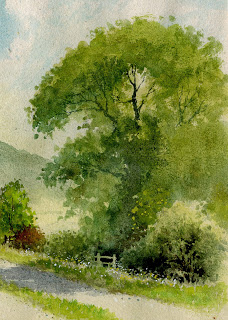The onset of spring nearly always gives us all a sense of hopeful anticipation of more pleasing times to come, perhaps more so this year than ever before as we attempt to recover from this dreadful virus. I hope you are able to get outside and take advantage of the better days, and perhaps manage a sketch or two. For me, daffodils always make a powerful foreground feature, and it’s worth capturing some images of these while you are out.
This image is part of a painting depicting lambs in early spring. Sheep are relatively easy to draw, but can pose problems for the unwary at the painting stage, especially where you have a light-coloured field caught in sunshine: you need a slightly darker area behind the sheep so that it stands out, and as you can see in this painting I have included several darker patches of grass in order to highlight the sheep. Generally I use Naples yellow for the main body, often leave a white top on head and body to accentuate the sense of light. This is normally left as white paper, but touching in a little white gouache can help rescue one that has not quite worked.
When including lambs it is important to put across a sense of the relationship between mother and lamb, or between a number of lambs enjoying each other’s company. This makes it look so much more natural. Compare the lamb by its mother in the foreground with the one on the distant right which is lying on it’s own. The closer couple invoke a much more pleasing composition.
One of the stronger background features is the gate. Although this has nothing to do with springtime I mention it because it is a good example of negative painting. Here, I have worked the darker colour around the gate and posts to define the light woodwork. I never include all five or so bars as it’s good to keep some hidden in the long grass! The painting was done on Saunders Waterford NOT 140lb paper.
Enjoy springtime, and you can find more help on seasonal work in my book Landscapes Through the Seasons in Watercolour, which you can obtain as a signed copy from my website www.davidbellamy.co.uk





